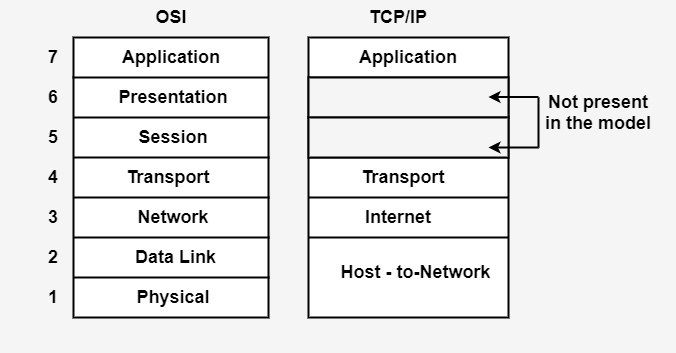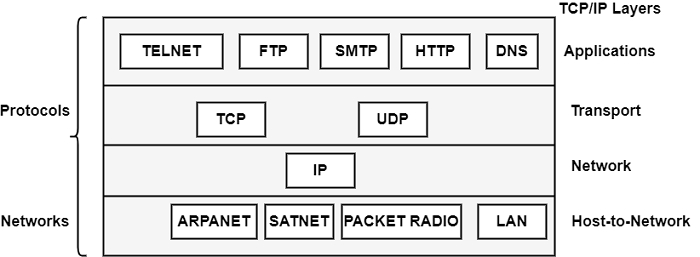
 Data Structure
Data Structure Networking
Networking RDBMS
RDBMS Operating System
Operating System Java
Java MS Excel
MS Excel iOS
iOS HTML
HTML CSS
CSS Android
Android Python
Python C Programming
C Programming C++
C++ C#
C# MongoDB
MongoDB MySQL
MySQL Javascript
Javascript PHP
PHP
- Selected Reading
- UPSC IAS Exams Notes
- Developer's Best Practices
- Questions and Answers
- Effective Resume Writing
- HR Interview Questions
- Computer Glossary
- Who is Who
What is the TCP/IP Reference Model?
TCP/IP signifies transmission control protocol/Internet Protocol. It was created by Defence Advanced Research Projects Agency (ARPA, later DARPA) in the late 1970s. It is a collection of communication protocol. It involves collection and methods for managing with packet transport, media access, session interaction, data transfer, email and terminal emulation.
The TCP/IP reference model has four layers, as display in the figure −

Host to Network Layer
This is the lowest layer in the TCP/IP reference model. The layer functioning is usually different in various relations. The main function of this layer is to instruct the upper layer when the host is linked to the network so that they can establish sending the data packets.
Internet Layer
The functioning of the TCP/IP model’s internet layer is similar to the OSI model’s network layer’s functioning. This layer’s function is to enable the host to add packets into any relation and then create them transit separately to the target.
Transport Layer
The transport layer is placed above the internet layer of the TCP model. This layer functioning is equal to the functioning of the transport layer in the OSI model. In the transport layer, the byte flow is split into communication, and these communications are developed to the internet layer. It can support the functions like segmentation and disintegration of messages. This protocol is used in this layer are TCP and UDP.
TCP
TCP represents Transmission control protocol. It is a dependable connection-oriented protocol. It enables a byte flow broadcasted from one system to be delivered to another system without learning some bug. It can also manage flow control.
UDP
An uncertain, connectionless protocol used for applications that do not need the TCPs series or flow control. It can be used in sending speech or video.
Application Layer
This is the highest layer of the TCP/IP layer. The application program’s layer view is a user-oriented layer that helps services provide the network’s end-user precisely. A message or information to be transmitted across the network introduce the TCP/IP model and then carry down into the communication line up to host to the network layer of destination and then upwards up to the receiver end framework application layer.
This layer uses various protocols to transfer the data between applications. Some standard protocols used in this layer are −
FTP (File Transfer Protocol)
It is used for file transmission between internetwork nodes.
SMTP (Simple Mail Transfer Protocol)
It can be used for exchanging email.
TELNET
TELNET represents Terminal Network. It allows the client to create host-based software by initiating one of the host terminals. It also supports connectivity between the diverse operating framework.
DNS (Domain Name Systems)
The DNS can change the domain name into IP addresses. The TCP/IP protocol needs the IP address that recognizes linking a host to the computer network.
HTTP (Hypertext Transfer Protocol)
HTTP is an internet protocol created for a particular software, the World Wide Web (WWW).
Main protocols and networks in the TCP/IP reference model are shown in the figure −


